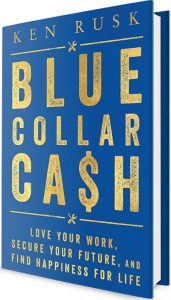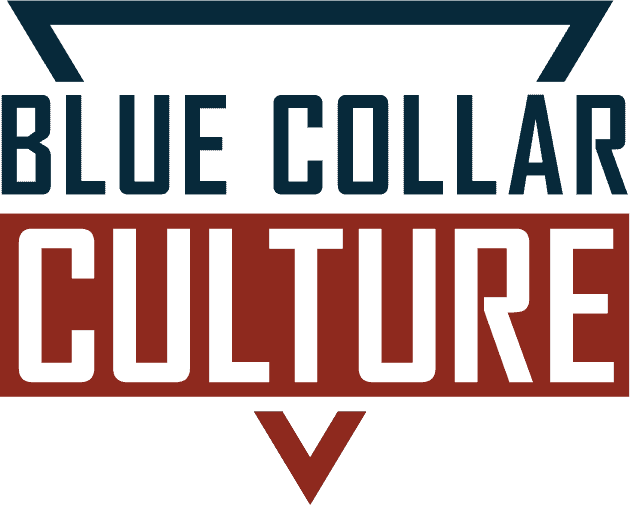
Growing up, we are pushed towards pursuing certain professions in college that often stigmatizes the very idea of working with your hands, of being a blue-collar worker. Helping change that mindset, Ken Rusk, a blue-collar construction entrepreneur, takes us to his mission of changing that mindset, discussing the lucrative business found in America’s supply and demand environment and how he is helping others change their lives through his company. He then talks about his leadership style, hiring process, and book, Blue Collar Cash. Join Ken in this episode where he empowers those in the industry as he follows his journey to make a change to blue-collar.
—
Make A Wish To Change Blue Collar
It’s not every day that we get to have a conversation about getting started in the trades or what it takes to run a successful business. We’ve had a lot of amazing guests on the show that have talked about their story and their journey. Our guest has a bit of a different approach to what it takes to get out there and be successful in the trades. He went to college for a few months and decided it wasn’t for him. He came back out and now he owns multiple construction companies. He’s got a tremendous wealth of knowledge in this area. I want to welcome our guest, Ken Rusk. Welcome to the show.
Thanks for having me. I appreciate it.
You’ve been on a journey here that’s been solid over your professional career. As you’ve grown these construction companies, as you’ve worked with other construction company owners, what would you say is the biggest myth about the industry?
It’s the stigma of working with your hands. In this day and age of this almost forced-college path where all the high schools have suddenly turned into college prep schools, there almost became this, if you weren’t going that path, you were doing something less. I can tell you that nothing could be further from the truth. Working with your hands is not only honorable but it’s lucrative, especially in this environment of supply and demand, and the problems that we face with supplies of American blue-collar workers.
It is a push there through the high school growing up. I don’t think it quite starts in high school. I think it starts in kindergarten that they started talking about the college push and showing that college has to be in that destiny if it’s going to be anything close to it. You’ve not found that to be the case, is that correct?
That’s true. I don’t know if it was intentional or unintentional, but it seems somewhere in the ‘70s and ‘80s they decided to get rid of shop class and they filled those rooms with computers. I’ve always said that we need to learn computers. That was important, but I never thought it was a binary choice, meaning one had to substitute for the other. We eliminated the potential discovery of the trades by millions of kids, because they went right into these classes after these shop classes were eliminated. That has paired up with the fact that technology gives us these cell phones and iPads that instead of building a tree fort in our backyard, we build it on Minecraft on our screens. We don’t get to discover those types of things. I agree with you 100%. We’re in a position where we could use a lot more education as to the lucrative careers that these paths can take you.
I know you’re on a mission to change the mindset around blue-collar, working with your hands and working in the trades, whether it’s at this executive level of owning your own small business or it’s just working in that. Tell us a bit about what you’re doing there to help change that mindset.
Working with your hands is not only honorable, but it's lucrative, especially in this environment of supply and demand. Click To TweetIn addition to writing the book and putting it out there, what we’re doing is we’re trying to get the word out to the kids before they get into that almost corral of no return, which is their 9th, 10th, 11th grade, and they’re thinking, “I’ve got to prepare myself for college.” We’re trying to catch them in the early stages and talk about the benefits of blue-collar work, the honor in that, the control of that, and the money that you can make doing that. We’re talking to people in as early as 6th and 7th grade about what the benefits are in these fields. Anybody can understand supply and demand. It’s a powerful force. If everybody’s going one way, then the contrary thinker would go the other way, because as we overproduce college graduates with nondescript business degrees, we’re underproducing people who can do things with their two hands. If the supply is there and the demand is high on the blue-collar side, then the money is naturally going to follow that path.
I love that you say we should go the other way. It was something that we all see. Unfortunately, the herds don’t see that in any situation. I’m thinking of Warren Buffett. He was asked how he always knew what to invest in. He said, “When everybody was running one way, I always ran the other way.” That was an investment strategy. It’s proven fairly well. When you’re saying this about going in the path that not everybody is going, “Everybody is going to college, let’s go the other way. Let’s look at how do we do it with our hands when everybody is doing it virtually.” You’ve been on this journey and I know that you’ve seen some amazing results and changes. Tell us about 1 or 2 of those that you’ve seen that have inspired you and your work, and inspired you to communicate that to the rest of the world.
I’ve had to hire a lot of people. We started with six people, and now we have 200. That caused us to have to hire a lot of people. I almost became an involuntary life coach during that period of time. I enjoyed it because I saw that a lot of these kids weren’t prepared out of high school to deal with the real world. What would happen to them is they would get out of school and the parents, the teachers, the society in general would hand them a hatchet and say, “There’s the forest, start chopping.” After five minutes, they would turn around and say, “Where am I going?” The best answer they got was, “I don’t know, keep chopping.” As if they were going to stumble across their success path. It’s a lot different than that. I believe in some of the age-old theories that you’ve got to begin with the end in mind. You’ve got to believe that you have a path to getting there.
I used a lot of real simple techniques where people can visualize what they want their life to look like, and we get them down on paper doing it. We get them with poster boards and crayons or markers or whatever they want to use. We have designed what they want their life to look like, what their version of comfort, peace and freedom might look like. That can be anything from how you want to live, what type of house, an apartment, a condo, in the city, in the suburbs, in the country. What vehicle they would see themselves driving, a car, truck, minivan. What their hobbies are, what their pets look, what the names of those pets might be, what their giveback moment is, what charity they would support. We try to get them detailed into those drawings so that they understand that they’re in control of making that happen. What I love about that is the more clearly they have that picture, the more they look back at me and say, “Ken, thank you for the training. Get out of my way and let me go get it.”
Isn’t that a little foolproof for blue-collar?
It’s not, because when you ask somebody, “What are your next six months going to look like?” they have no idea how to look back at you and answer that question other than, “I’m living for Friday.” We like to take a good long-term interest. If you’re looking to cut down on turnover, and everybody knows that turnover stinks. It’s expensive. It takes a lot of time. You train these people, and they don’t come back. I’ve always believed, and I’ve said this hundreds of times, I can’t get what I want, nor can my company get what it wants until all of you get what you want first. We better have a clear idea of what it is that you want for yourself, because I want you to believe you can build your life with and through my company. I work a lot on retention and building corporate culture. That’s one of the first exercises that we talk about. Believe me, it is effective. I don’t care what walk of life you come from. You should give us a shot.
I threw you that question. I don’t believe it’s foolproof, though but it sounds like it is. They think, “The construction guy, they will never take this.” In my own businesses and getting to understand, “Why are you doing all this? Where do you want to be six months from now and not 300 years? What’s your dent in the universe?” We’re not there, although those are important. I’m talking about six months from now. What does that stuff look like? One of the support team has said this, one of my clerical people at the body shop, when I dug into what she was wanting, why she was working. She wanted to own her own home.

“How much do you have to make to own your own home?” We worked it out, figured it out, thought it through, and it was going to be a lot more than what she was making. I said, “Let’s figure out a path to get there.” She started working on learning stuff and getting better. There was a purpose to her job. It wasn’t putting invoices. It was getting a home. She owns a home now and has a great life. That’s because we get real with that stuff. By no means is that soft. We’re all going out there and striving for something. Getting that real is important. Too often as leaders, we’re not getting there. In all of these great successes that you’ve done, all these cool things that you’ve gotten to see, what’s the best mistake you’ve ever made?
The best mistake I ever made was realizing that I didn’t have to know it all. I didn’t have to have all of the answers. I didn’t have to be the Shell Answer Man. For me, letting go of this title of President or CEO or boss or owner, I don’t like any of those terms. I always say that if you put me in the parking lot with all 200 of the people that work on our team, I wouldn’t want anyone to be able to pick me out of the group as, “There’s the boss, that’s the owner, that’s the guy.” When we build our buildings, we do them campus style. We don’t do them 3, 4, 5-floor style, because I believe that that tradition is out the window.
The best thing that I had done was I let go of me thinking I had to drive these companies. I got a lot of feedback from the people within the companies and said, “What do you guys want to do? How far can we go? If we get there, what do you want for doing it?” They look back like I was from Mars because no one had ever talked to them like that before. We had this huge collective effort that was driven by not only what they thought they could gain from the company at the end of the year, at the holiday season, but they each had to have a powerful map of what they wanted for themselves. That took me a lot further than I could have taken it myself. There is power in letting go of that and allowing people to do what they want to do in a big collective way.
How did you come to that discovery? That is not the age-old way that has been broken down. How did you come to realize that?
I wore a lot of hats and I know a lot of business owners out there wear a lot of hats. I said to myself, “What am I good at? What do I like to do? What needs to be done, but may not be my best skillset?” I thought, “If I could find people to help me with those skillsets, would the results be better than if I did it myself or attempted to do it myself?” The answer was yes. In every case, when I shed something that I knew was important, but maybe wasn’t in my wheelhouse. First off, you have to let go, and that’s important, and that’s okay because your ego doesn’t want you to do that. You let go, you get people in place to do these things, and I guarantee you your company will go further than if you try to do all those things yourself. I don’t know whether I got tired of doing a mediocre job at some of these things, or I gravitated too much towards where I knew I was good at. Building a support team is the best thing you’re ever going to do.
When you’re saying that about letting go of things, I had some body shops at one point. The painter position inside of a collision center is like the unspoken leader of the body shop. In every body shop that I’ve ever been around or worked, the painter has the upper level in a lot of areas. Picking a painter for your shop is critical. I remember I was on the journey of discovering letting go of all these things and letting others do it. I’m not fully there, but I was in the discovery path. We got down to two phenomenal painter choices, top notch. There was one. I thought this guy is it. He’s got energy. He’s going to bring some drive and momentum to the company. The other one is qualified and it seems he’s going to do good work, but he’s not the same as this first one.
I had begun to work with the team on these kinds of things. I let the actual team that was going to be working with him in that shop to make the final call. They picked the one that I didn’t want, and unfortunately, they told that guy that too, which he continued to rub in my face for years. It turned out they had picked up on him and how great he was. You don’t always get to know that you made the right choice, but on this one, I got to see the end of both decisions. We got a painter that was a solid, steady, driving force of our company and did amazing stuff.
You’ve got to begin with the end in mind. You’ve got to believe that you have a path to getting there. Click To TweetThe other one got us on his email. We got connected to his emails at 3:00 in the morning. Let’s just say we shouldn’t have been connected. We got some emails and like, “We would not have made the right choice with that one.” That was letting the employees who get to see a little bit more of the real. You said you don’t want to be that boss or that owner when it’s all 200 of you there. Even when you are trying not to be that, they’re putting a bit more of a show on for you than they are for their coworkers. Letting them go to that spot where they’re there with their people. Those are the ones making a decision, it’s a better team.
At some point, I realized that I have to have the knowledge that I and the company need to run all the different facets of it. In my experience, it seems like it’s never been that important what I know, as much as it has been important what they know and how they execute that. I didn’t want to have to plug myself into any one particular position. I wanted to be able to touch every position in the way of motivating and helping create life plans and long-term vision plans for the people doing those things without having to perform any one of those things individually myself. You always hear about the word empower. It made it so much better to give them the keys of operating these certain parts of the business. Tom Golisano in his book, he’s the Founder of Paychex, calls them entrepreneurial employees. What he was talking about, which is important is people feel they own and run their little departments or divisions, even though they don’t own the company. Those divisions are directly connected to their financial well-being. If you can get that mindset going, your company is going to go a lot further than you’re ever going to take it on your own.
Every human being wants to make a difference and wants to be a part of a team. By being a leader, our job is to supply those to them and the direction for that. That’s where we went when we give them those. I know you’ve written the book, Blue-Collar Cash, and you’ve gotten to work with lots of different business owners and employees. What is the biggest thing holding back a business from breaking free? They’re right there and they keep almost making it, but you see it and you’re like, “If you just did this.” What is it?
It’s getting people together, asking their opinion, what they’re capable of, and then putting a plan together to do that, and then rewarding them at the end. It comes back to how we see ourselves. Do we get to go home at night and when our wives or our girlfriends ask us, “How was your day?” Are you going to come from ego where you say, “I answered all these questions. I solved all these problems?”
I talked to a lot of business owners in the blue-collar space that struggled with letting go. A lot of it stems from their holding onto some of the past hurt of hiring someone they thought was amazing, giving them the keys to the castle, and then watching them burn it down. They’re skeptical of people going forward. Trust is something that they don’t use openly with their team. In a lot of the work that we do in building the core fit hiring system for these companies is to help them overcome that and put objective tools in place so that they can take the emotion out of it.
It sounds to me, you put a lot of your success on the team that you’ve built. You started with six employees, now you’ve got 200. That doesn’t happen overnight and it wasn’t easy. What are some tips or maybe the number one thing you’ve learned when it comes to finding these people? What’s the one thing that you would tell our readers, “Here’s how you find the person that you want to delegate this stuff to. Here’s the way you find the person that you’re willing to trust and you’re willing to step back and let them take it over?” What’s 1 or 2 things that you could share?
I’m glad you asked it because this one came to me while I was realizing the whole letting go thing. It seems that in this day and age especially with technology, there’s so much demand out there. If you drive from my office a couple of miles to the freeway, there are twenty signs that say, “Hiring.” They have the ability to job shop you six ways from Sunday. When you’re in the interview, it used to be the boss man would sit behind the desk and say, “Why should I hire you?” That’s flipped a bit. Now, the people on the other side of the desk are looking back and saying, “What’s in it for me to work here?” That might be off putting for some potential bosses who are used to things the way they were. If somebody says to me, “What’s in it for me to work here?” I’m intrigued by that.

That’s a positive for me because my question is going to be, “What are you looking to accomplish with this job? Tell me about what you want your life to look like. Tell me about your six months, your one year, your five years. Tell me something beyond next Friday’s paycheck. What does that look like to you?” If I get a good answer there, I’ve got a good prospect. I would rather have somebody that’s working for themselves through your company and with your company, than you having to micromanage every move that they make. If I got a guy or gal that’s strongly driven as to where they’re going, I’m taking a chance on that person for sure.
People are better at motivating themselves than letting someone else drive or hold a carrot in front of them so that it motivates them. When you were talking about that, “What’s in it for me?” I call that with them. It’s a marketing term. We realize the roles have flipped. I talk to employers all the time. They’re like, “I can’t find good people.” The question I always ask is, “You can’t find people or you can find people, they’re just no good?” It’s always the latter. They always can’t find good people. When I ask them what good means, they want people that give a damn. That’s how I sum it up. They care. That’s been lost on the industry, “This person is a cog in my machine. I’m going to treat them like it. If they don’t work out, I’ll put a new cog in the machine.” The modern workforce is not having that. They don’t want to be treated that way. When they’re looking for good people, they’re looking for people that give a damn, that have goals and dreams, that are willing to wake up and trade their paycheck for a purpose. They’ve got something that they’re aligned to.
There’s an important point to add to that. In the book, I talk about the difference between the somedayers club and the todayers club. Those are two different clubs that you can belong to. One of them where you live in perpetuity of, “Someday I’m going to make that happen. It’s going to be great. I’m going to get there and it’s going to be awesome.” The other club is, “I’ve done this. This is how I’m doing it. I’m repeating that successful path. I’m going to create steps and make this happen. I’m going to show you my results.” The difference for me is, when I’m interviewing somebody or I want to know about their future, I’m going to ask them what they’ve already accomplished. I’m going to also ask them of the things that they’re looking to accomplish.
What are the steps involved in that? “Do you have a path? Do you have steps? Do you have it broken down?” We have this big black glass board in our office. It’s probably a 10×10. We have these multicolored, bright markers, like you’d see almost out in front of a bar where they have the drink of the day, and they draw the pictures of the drink. We have them put those things on that board with a start date and end date and a mechanism that shows certainty, “I’m saving $2,500 and it’s going to take me a year. It’s $48 a week. It’s coming out of my paycheck. It’s into an account that I can’t touch. There we go, I’m on the path.”
It has to be crystal clear. It has to have a lot of clarity there. That’s something that anybody reading can start tomorrow. Once you have somebody that’s done that once or twice, and they go from a somedayer to a todayer, you’re going to have a person that’s going, “I like the way that feels. All I had to do is breathe and that goal is going to happen. I’m going to do that again and again.” That’s what we’ve experienced with people here. They’ve maybe paid off a Visa card, then they got their first car. They saved for a down payment on the house and they’re living in that house and they’re taking vacations. They try to give me credit for that. I’m like, “No, all we did was designed a path. You walked it. We had the vehicle.” It’s something that any business owner out there could use starting today.
We’ve challenged you. We’ve asked a lot of questions here as we’ve dug into this. I’m going to ask you to challenge our readers. What is something that they should do today? Not someday, but today. What is that one thing that they should do to take action from what they’ve read?
If they’re an individual, they need to find a quiet place. They need to sit down, and they need to draw out what they want their life to look like. That has to happen. Here’s a statistic that you might be interested in. If you take 100 people, 80 people in the United States claim they have no real goals, so that leaves 20. Of the 20, 16 people have goals, but they’re hopes, dreams, wishes and somedays. That leaves four. Of the four out of those 100 people, they write their goals down, draw them out, have them crystal clear, cut out pictures from magazines, make a puzzle, and yet 3 of those 4, take those goals and shove them in a drawer somewhere, maybe never to be seen again.
The Law of Attraction is powerful. What you see, you tend to attract yourself to. Click To TweetOnly one of those people is willing to take those goals, write them out, post them on the wall, in their bathroom, in the dashboard of their car, maybe in their kitchen, where they look at them every single day. Those people on average earn eight times more money than the other 99 in their lifetime. That was a study done by the University of Virginia. I would implore anybody that’s reading to sit down, draw your life as specifically as you can. Keep that in front of you. Look at it every day, because what happens is the Law of Attraction is powerful. What you see, you tend to attract yourself to. Keep that in front of you and you will see your life change quickly.
I would only imagine that someone that has never drawn their life before, has never written down their goals. They’re going to go away. They’re going to sit down and do what they can with this. If they get stuck, do you have any resources or anything to help them to get unstuck? Where can they go to get clear on what they need to be doing during this time?
Two brief stories. The easy one is to read the book. I talk about that particular issue because it happens a lot.
The book is?
Blue-Collar Cash.
Blue-Collar Cash by Ken Rusk. We get it on Amazon or anywhere?

They can get it on Amazon, IndieBound, Apple Books, anywhere books are sold. The other answer is this. This is a brief story. Do you remember when you were younger and the first time ever that you wanted to jump off the high dive and you were scared to death? You talk yourself out of it a half a dozen times, and then finally your buddies were all sitting there next to you and they said, “You’ve got this, you can do this.” You climb the ladder and looked over at them. You climbed up, got to the top and looked over at them. You walked down that handrail towards the water and then the board started giving underneath your weight. You’re scared to death then you look over at them and finally, they look at you and they say, “You’ve got this.” What do you do? You launch yourself off the high dive.
It’s the same exact thing when you’re trying to do these goals in your lifetime. You need to find one person that you can trust. That maybe a family member or it may not be a family member. It maybe a mentor. Find someone that you can trust and share these goals with in crystal clear detail and say, “I want to get this done. Of all the people in my life, I’ve picked you to help me.” Once you’re walking a path that you can’t turn around on, you may hesitate and stumble, but that person will be there with their hand on your shoulder. They are invaluable to taking you down your first goal path. Once you’ve done it successfully on your own, you may not need them anymore other than to say, “I have gratitude. I give thanks for you for being in my life.” To have someone there with their hand on your shoulder, it’s an invaluable force to keep you on that path.
For all of you out there, Ken is pointing to a couple of different things here. One, get the book, Blue-Collar Cash by Ken Rusk, anywhere that you can find that. It’s a great read. The other thing is when he’s talking about being specific. You all know and we talk about it a lot, the clearer that we are with this stuff, the more concrete that we are with it. That’s what I love that you’re pushing for us, Ken. Be specific about it because that allows us to see it and allows that partner that we selected to hold us accountable to it. We don’t want to be like, “Did I get that?” We want to know for sure. Ken, this has been an amazing segment. I’m glad that we’ve been able to spend this time with you. You do have a special offer with the book, and I want to make sure that we highlight that for our readers. I’ll let you share that, share where to go, and share your website with them so they can have any way to get ahold of you if they have any more questions with it.
First off, thank you for having me. It’s been fun. I always love these discussions. If you go to KenRusk.com, you’ll see what we’re up to there. You can get the book there as well. It has all the buy buttons on it. We also have @KenRuskOfficial on our Facebook page and Instagram. We have a blog on Facebook and we have a constant content to support the blue-collar industry because I’m fond of that. At the end of this thing, I always believe that giving back, it was the last chapter I wrote in the book about the power of giving back and how you don’t do it for any specific reason, but it seems to enrich your life. Believe me, it does.
I’ve sponsored Make-A-Wish for several years. I’ve done Kids Wish every single year. This 2020 is no exception. We’ve made a long-term commitment. One of the things I want to do is, anyone who buys a book, I want you to know that my author revenue from the book is going to go towards sponsoring Make-A-Wish. I’m trying to do multiple wishes this 2020 and into the spring. I would encourage anyone to buy it as a gift for someone else, maybe a young person that’s in their life that they need some direction, or maybe you’re in your midlife and you want to get out of the cubicle and go back to working with your hands because you feel passionate about woodworking or a craft or a skill. Pick this book up and know that you’re not only getting yourself some good information, but you’re also going to help some child in need to realize a wish to Make-A-Wish this 2020.
Thank you, Ken, for joining and thank you all for all out there that are reading. Go to KenRusk.com. He’s got all kinds of great content. Get the book, Blue-Collar Cash, and we look forward to seeing you next time. Thanks, Ken.
Thank you.
Important Links:
- Ken Rusk
- Blue-Collar Cash
- Amazon – Blue-Collar Cash
- IndieBound – Blue-Collar Cash
- Apple Books – Blue-Collar Cash
- @KenRuskOfficial – Facebook
- Instagram – Ken Rusk Official
Who Is Ken Rusk?
MEET THE AUTHOR
 Ken spent his younger years digging ditches and working in construction. He never went to college. Instead, he made goals, planned, and worked hard for thirty years. Now, Ken is a very successful entrepreneur with multiple businesses and revenue streams.
Ken spent his younger years digging ditches and working in construction. He never went to college. Instead, he made goals, planned, and worked hard for thirty years. Now, Ken is a very successful entrepreneur with multiple businesses and revenue streams.
Ken Rusk specializes in mentoring and has coached hundreds of young people in areas such as short-, mid-, and long-term goal setting, life visualization, career paths, and sound financial planning. He is passionate about helping people achieve their dreams regardless of their educational background or past.
